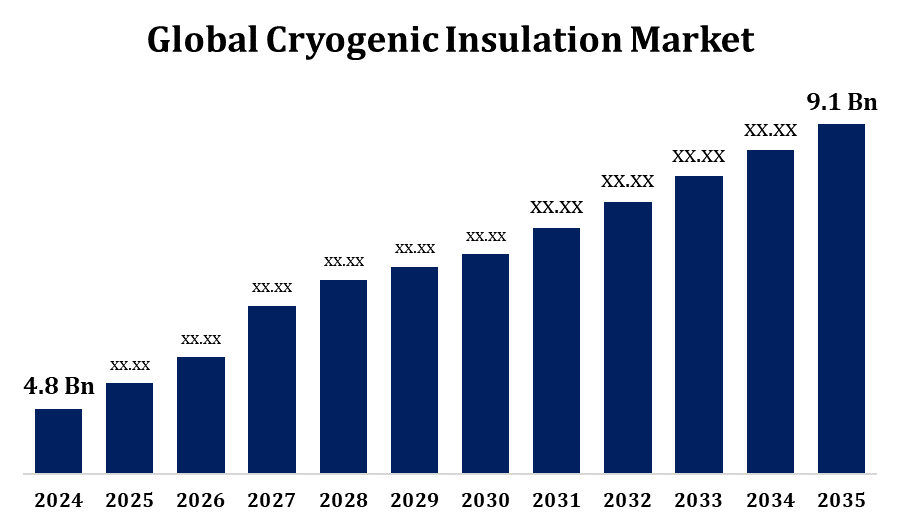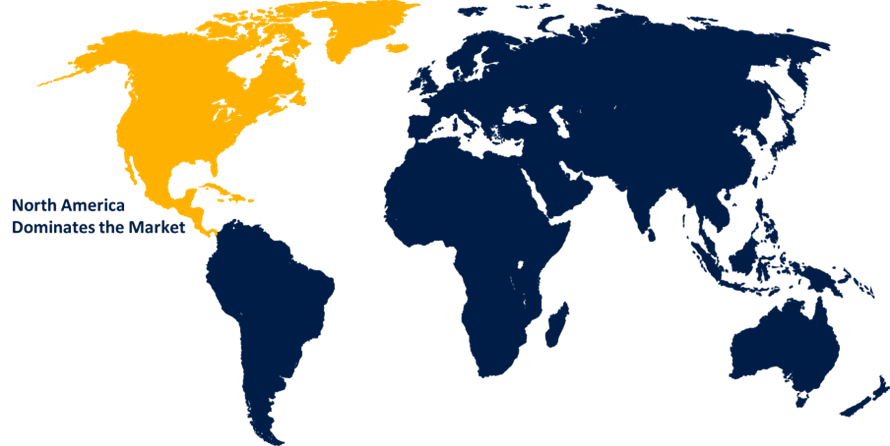Global Cryogenic Insulation Market Size, Share, and COVID-19 Impact Analysis, By Material Type (PU/PIR, Polystyrene and Cellular Glass), By End-Use Industry (Energy & Power, Food & Beverages, Chemical and Medical), and By Region (North America, Europe, Asia-Pacific, Latin America, Middle East, and Africa), Analysis and Forecast 2025 - 2035
Industry: Chemicals & MaterialsGlobal Cryogenic Insulation Market Insights Forecasts to 2035
- The Cryogenic Insulation Market Size was valued at USD 4.8 Billion in 2024.
- The Market Size is Growing at a CAGR of 6.61% from 2025 to 2035.
- The global Cryogenic Insulation Market Size is Expected to reach USD 9.1 Billion By 2035.
- Asia Pacific is expected to grow the fastest during the forecast period.

Get more details on this report -
The Global Cryogenic Insulation Market Size is Expected to reach USD 9.1 Billion By 2035, at a CAGR of 6.61% during the forecast period 2025 To 2035.
The cryogenic insulation market is experiencing significant growth due to the rising demand for liquefied gases such as LNG, liquid nitrogen, and liquid oxygen across various industries, including energy, healthcare, aerospace, and chemicals. This insulation is essential for maintaining extremely low temperatures and preventing energy loss during storage and transportation. The expansion of LNG infrastructure, especially in Asia Pacific, North America, and the Middle East, is a major driver of market growth. Additionally, the increasing adoption of cryogenic technologies in medical and space applications further supports demand. Technological advancements in insulation materials such as aerogels, polyurethane foams, and perlite are enhancing performance and efficiency. Moreover, the global push for cleaner energy solutions is accelerating investments in cryogenic equipment, thereby fueling the growth of the cryogenic insulation market.
Cryogenic Insulation Market Value Chain Analysis
The cryogenic insulation market value chain comprises several key stages, beginning with raw material suppliers providing essential components like polyurethane, perlite, aerogels, and fiberglass. These materials are then processed by manufacturers to develop high-performance insulation products tailored for extremely low-temperature applications. Component suppliers and fabricators play a role in assembling and customizing insulation systems for specific end uses. Distributors and logistics providers ensure timely delivery to various sectors, including energy, healthcare, aerospace, and industrial gas industries. End users such as LNG facilities, cryogenic storage plants, and medical institutions utilize these systems to maintain product integrity and operational safety. The value chain is also influenced by regulatory bodies, research institutions, and technology providers, which drive innovation and compliance, ensuring continuous improvement in insulation performance, sustainability, and cost-effectiveness across applications.
Global Cryogenic Insulation Market Report Coverage
| Report Coverage | Details |
|---|---|
| Base Year: | 2024 |
| Market Size in 2024: | USD 4.8 Billion |
| Forecast Period: | 2025 - 2035 |
| Forecast Period CAGR 2025 - 2035 : | 6.61% |
| 2035 Value Projection: | USD 9.1 Billion |
| Historical Data for: | 2020-2023 |
| No. of Pages: | 240 |
| Tables, Charts & Figures: | 121 |
| Segments covered: | By Material Type, By End-Use Industry, By Region and COVID-19 Impact Analysis |
| Companies covered:: | Aspen Aerogels (US), KAEFER (Germany), Aspen Aerogels (US), BASF SE (Germany), Armacell Enterprise GmbH & Co. KG (Germany), Lydall Inc (US), Cabot Corporation (US), DUNMORE (US), Owens Corning (US), Röchling (France), and other key vendors. |
| Pitfalls & Challenges: | COVID-19 Empact, Challenge, Future, Growth, & Analysis |
Get more details on this report -
Market Dynamics
Cryogenic Insulation Market Dynamics
Rising demand for clean and environmentally sustainable energy sources is expected to propel market growth
Rising demand for clean and environmentally sustainable energy sources is expected to propel cryogenic insulation market growth in the coming years. As countries shift toward low-carbon economies, liquefied natural gas (LNG) is gaining prominence as a cleaner alternative to coal and oil, driving the need for efficient cryogenic storage and transportation solutions. This transition increases demand for advanced insulation materials that can maintain extremely low temperatures while minimizing energy loss. Moreover, cryogenic insulation is essential in supporting renewable energy technologies, such as hydrogen storage and carbon capture systems. The growth of the healthcare, aerospace, and electronics sectors further adds to demand, where cryogenic applications are critical. As environmental regulations tighten globally, innovations in eco-friendly and energy efficient insulation solutions are creating new opportunities in the cryogenic insulation market.
Restraints & Challenges
One of the primary issues is the high upfront cost associated with advanced insulation materials such as aerogels and vacuum-insulated panels, which can be prohibitively expensive for small and medium enterprises. Additionally, the technical complexity of designing insulation systems that function effectively at extremely low temperatures requires specialized expertise, limiting widespread adoption. Raw material price volatility, particularly for petroleum based products like polyurethane and polystyrene, also affects cost stability and supply chain reliability. Furthermore, stringent regulatory requirements related to safety, environmental impact, and energy efficiency add to compliance costs and push the industry toward developing eco-friendly alternatives. Lastly, maintaining insulation performance under extreme conditions and repeated thermal cycling remains a significant durability challenge, leading to increased maintenance demands and potential reliability concerns.
Regional Forecasts
North America Market Statistics

Get more details on this report -
North America is anticipated to dominate the Cryogenic Insulation Market from 2025 to 2035. The region’s leadership is driven by its advanced LNG infrastructure, rising investments in clean energy, and the presence of cutting-edge material technologies. The United States is at the forefront, supported by a robust network of LNG terminals and growing industrial gas consumption. Additionally, the healthcare and aerospace sectors contribute to steady demand for cryogenic insulation. In Canada, increasing industrial activities and a supportive economic environment are fueling market expansion. The shift toward LNG and hydrogen energy, along with strong environmental regulations, is accelerating the adoption of high performance insulation materials such as polyurethane, polyisocyanurate, aerogels, and vacuum-insulated panels. Although the market is mature, opportunities remain in retrofitting and technological advancements.
Asia Pacific Market Statistics
Asia Pacific is witnessing the fastest market growth between 2025 to 2035. The growing use of liquefied natural gas as a cleaner energy source is encouraging investments in storage, transportation, and terminal facilities, boosting demand for efficient insulation solutions. Additionally, the region sees strong usage across sectors like petrochemicals, shipbuilding, aerospace, and electronics. China remains the largest market, while India is experiencing rapid growth due to increased energy needs and industrial expansion. Government initiatives focused on energy security, emission reduction, and the development of healthcare infrastructure continue to support market growth. Technological advancements and retrofitting of existing systems further present opportunities for expansion in the region.
Segmentation Analysis
Insights by Material Type
The PU/PIR segment accounted for the largest market share over the forecast period 2025 to 2035. The growth is due to its excellent thermal insulation properties, structural strength, and resistance to moisture. These materials are lightweight, durable, and highly efficient, making them ideal for use in LNG tanks, pipelines, valves, and transport systems. Their ability to perform under extremely low temperatures has led to widespread adoption across the energy, petrochemical, and marine sectors. As global LNG infrastructure expands, the demand for PU/PIR insulation continues to rise, supported by increasing investments in storage and transportation facilities. Additionally, ongoing technological developments are enhancing the performance and application range of these materials, further solidifying their position as a preferred choice for cryogenic insulation in various industrial applications.
Insights by End Use
The energy & power segment accounted for the largest market share over the forecast period 2025 to 2035. The growth is driven by the rising use of liquefied natural gas (LNG), hydrogen, and other low-temperature fuels. As the global energy landscape shifts toward cleaner and more sustainable sources, investments in LNG terminals, pipelines, storage tanks, and transport infrastructure have increased significantly. Cryogenic insulation plays a critical role in maintaining the extremely low temperatures required for these fuels, reducing thermal losses and ensuring safety. Materials like vacuum insulated panels and multilayer foams are widely used in power plants and related infrastructure. Additionally, the growing interest in green hydrogen and cryogenic energy storage systems is further boosting demand.
Recent Market Developments
- In April 2022, BASF developed a cryogenic insulation system for the transportation of cryogenic liquid cargo, including liquefied natural gas (LNG), utilizing its patented Elastopor Cryo technology.
Competitive Landscape
Major players in the market
- Aspen Aerogels (US)
- KAEFER (Germany)
- Aspen Aerogels (US)
- BASF SE (Germany)
- Armacell Enterprise GmbH & Co. KG (Germany)
- Lydall Inc (US)
- Cabot Corporation (US)
- DUNMORE (US)
- Owens Corning (US)
- Röchling (France)
Market Segmentation
This study forecasts revenue at global, regional, and country levels from 2025 to 2035.
Cryogenic Insulation Market, Material Type Analysis
- PU/PIR
- Polystyrene
- Cellular Glass
Cryogenic Insulation Market, End Use Analysis
- Energy & Power
- Food & Beverages
- Chemical
- Medical
Cryogenic Insulation Market, Regional Analysis
- North America
- US
- Canada
- Mexico
- Europe
- Germany
- Uk
- France
- Italy
- Spain
- Russia
- Rest of Europe
- Asia Pacific
- China
- Japan
- India
- South Korea
- Australia
- Rest of Asia Pacific
- South America
- Brazil
- Argentina
- Rest of South America
- Middle East & Africa
- UAE
- Saudi Arabia
- Qatar
- South Africa
- Rest of the Middle East & Africa
Frequently Asked Questions (FAQ)
-
1. What is the market size of the Cryogenic Insulation Market?The global Cryogenic Insulation Market is expected to grow from USD 4.8 billion in 2024 to USD 9.1 billion by 2035, at a CAGR of 6.61% during the forecast period 2025-2035.
-
2. Who are the key market players of the Cryogenic Insulation Market?Some of the key market players of the market are Aspen Aerogels (US), KAEFER (Germany), Aspen Aerogels (US), BASF SE (Germany), Armacell Enterprise GmbH & Co. KG (Germany), Lydall Inc (US), Cabot Corporation (US), DUNMORE (US), Owens Corning (US) and Röchling (France).
-
3. Which segment holds the largest market share?The energy & power segment holds the largest market share and is going to continue its dominance.
Need help to buy this report?